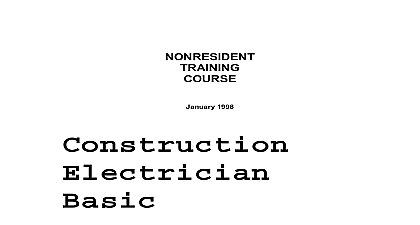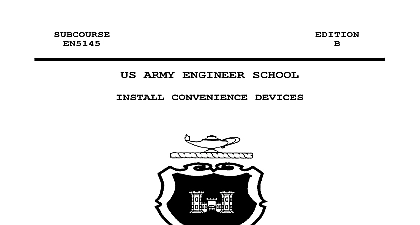INSTALL ELECTRICAL BOXES

File Preview
Click below to download for free
Click below to download for free
File Data
| Name | install-electrical-boxes-1368950742.pdf |
|---|---|
| Type | |
| Size | 1.58 MB |
| Downloads |
Text Preview
SUBCOURSE ARMY ENGINEER SCHOOL ELECTRICAL BOXES ELECTRICAL BOXES EN 5142 B States Army Engineer School Leonard Wood Missouri 65473 Credit Hour Date August 1999 OVERVIEW subcourse is part of the Electrician Military Occupational Specialty MOS 51R Skill Levels 1 and course It is designed to provide the knowledge necessary to identify and install various common of electrical boxes cover plates and special devices It also addresses how to calculate the of conductors allowable in an electrical box This subcourse is presented in one lesson that to the terminal learning objective as indicated below Work must be accomplished in a consistent with environmental laws and regulations are no prerequisites for this subcourse subcourse reflects the doctrine that was current when this subcourse was prepared In your work refer to the latest official publications otherwise stated the masculine gender of singular pronouns is used to refer to both men and LEARNING OBJECTIVE will learn to identify and install various common types of electrical boxes cover and special devices You will also learn how to calculate the number of allowable in an electrical box will be given the material in this subcourse and an Army Correspondence Course ACCP examination response sheet demonstrate competency of this task you must achieve a minimum of 70 percent the subcourse examination OF CONTENTS Overview i Electrical Box Installation 1 A Electrical Boxes 2 B Electrical Box Uses and Electrical Connectors 6 C Electrical Box Conductors 11 D Electrical Box Covers 15 Exercise 17 Key and Feedback 22 A List of Common Acronyms A 1 B Recommended Reading List B 1 C Metric Conversion Chart C 1 PAGE IS INTENTIONALLY LEFT BLANK INSTALLATION Task 051 246 1111 DESCRIPTION this lesson you will learn to identify and install various electrical boxes cover plates and special You will also learn how to calculate the number of conductors allowable in an electrical box LEARNING OBJECTIVE will learn to identify and install electrical boxes cover plates and special You will learn their installation procedures according to the NEC You will learn how to calculate the number of conductors allowable in an electrical box will be given the material contained in this lesson will correctly answer all practice exercise questions at the end of this lesson The material contained in this lesson was derived from STP 5 51R12 SM TG FM 5 and the NEC Handbook an electrical circuit is installed it will begin and end in an electrical box Electrical boxes are of various types of materials and come in a variety of sizes and shapes Electrical boxes can installed in many different ways and places for a variety of uses After the boxes are installed are installed in the boxes All electrical boxes must be covered when the work is completed A ELECTRICAL BOXES There are many types of electrical boxes They are made of either metallic or nonmetallic material The metallic box is widely used by the Army The NM box is becoming more popular it is less expensive and the installation of conductors is easier and faster than with the metallic Figure 1 shows a NM two gang box 1 Nonmetallic two gang box Electrical boxes come in many shapes sizes and depths Figure 2 Box depths range from inch to 6 inches Boxes of a special size and depth can be ordered 2 Common metallic boxes When required common metallic boxes can be ganged together to make the box wider 3 Boxes to be ganged must be of the same type and have a removable side If a box is not enough extension rings can be added to increase the cubic inch capacity as needed Figure 4 rings are attached to a box by tightening the screws 3 Box ganging 4 Extension ring Electrical boxes are mounted in several different ways Some boxes come with the mounting attached The side mounting box is attached to a stud with nails or screws Figure 5 5 Side mounting boxes The front mounting box is attached to a stud by hammering the spikes of the mounting into the stud Figure 6 page 4 This procedure is known as setting the box Nails and screws also driven through the mounting bracket to ensure that the box is securely mounted to the stud to movement 6 Front mounting boxes An adjustable bar hanger is designed for installation between wall studs ceiling joists or joists The bar hanger is nailed or screwed to studs or joists then a box is mounted to the bar Figure 7 Do not use a bar hanger if anything heavier than a light fixture is to be applied for do not use a bar hanger for a ceiling fan 7 Adjustable bar hanger Electrical boxes must be mounted so that the outer edge of the box will be flush with the surface of the wall Some boxes come with thickness gauges stamped on them Figures 8 and Align the gauge against the side of the stud Figure 9 Move the box in or out depending on the of the proposed finished surface Nail or screw the box to the stud 8 Gauged boxes 9 Gauge alignment Electrical boxes installed in walls constructed of noncombustible material can be mounted up 1 4 inch back from the finished surface Electrical boxes mounted in walls containing combustible must be mounted flush with the finished surface All electrical boxes including junction boxes should be mounted so that the conductors are Wall covering should never cover boxes Electrical switch boxes may be mounted 46 to 52 inches from the top of the box to the surface of the floor Outlet boxes may be mounted 12 to 18 inches from the bottom of the box the finished surface of the floor B ELECTRICAL BOX USES AND CONNECTORS Electrical boxes are used to mount a variety of devices such as switches light fixtures and outlets Figure 10 Special purpose rings Figure 11 can be added to a box to give it volume and versatility as to what type of device can be installed inside the box Electrical are also used as junction boxes Figure 12 A junction box is used when a circuit splits into two more directions and when splicing of wires is necessary 10 Devices 11 Special purpose rings 12 Junction box Electrical conductors wires are connected to a box with connectors Connectors come in sizes and shapes and are used to secure all types of cable or conduit to the box Figures 13 15 pages 7 and 8 All boxes have a limit to the number of conductors that can be installed in them These are explained in Part C page 11 13 Nonmetallic sheathed cable connectors 14 Flexible metal conduit and armored cable connectors 15 Conduit connectors Always use the appropriate connector for the type of cable or conduit being used The design the box also


